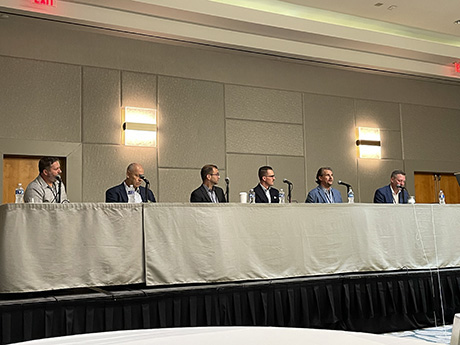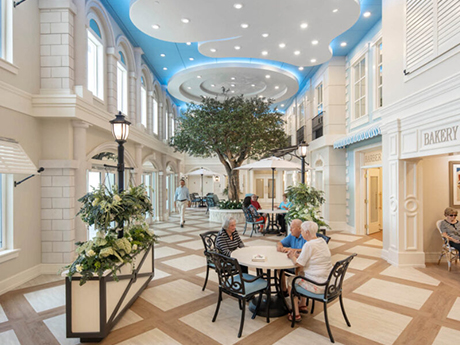ATLANTA — Though the older population is often seen as removed from modern technology, tech products offer great promise to the seniors housing sector. Participants in the “Technology Revolution: Enhancing Resident Care and Operational Cost Effectiveness” panel at the InterFace Seniors Housing Southeast conference (held recently in Atlanta) all agreed on this point.
Importantly though, the panel — which was moderated by Mark Petty, vice president of corporate accounts with ICON — also highlighted the fact that seniors housing is an industry rooted in human interaction. Given this fact, the panelists concluded that technology can complement and enhance, but never replace, the human touch.
Editor’s note: InterFace Conference Group, a division of France Media Inc., produces networking and educational conferences for commercial real estate executives. To sign up for email announcements about specific events, visit www.interfaceconferencegroup.com/subscribe.
Three Questions
A strategic approach in the purchase and application of technology within seniors housing communities is paramount, pointed out Joe Jasmon, CEO and managing partner of American Healthcare Management Group. In addition to being highly helpful, the products offered by tech companies can be costly.
“To have tech just to have tech is really a waste of time, effort and money,” asserted Jasmon.
During the panel, Jasmon laid out three questions to the audience regarding the prospect of a new tech product: 1) Is it going to help move someone into the community? 2) Is it going to help provide better care? 3) Can I make money using it?
John Rauls, president and CEO of Rauls Living, agreed that technology should be approached with intention.
“Technology has to be good, useful and efficient,” he said.
Rauls also argued that one of the biggest improvements that could be made would be that of greater collaboration between technology vendors and owners and operators to ensure that the products being marketed to the latter meet these criteria.
Where it can help
When it comes to providing better care, one of the most obvious and practical uses of technology in seniors housing communities is access control to ensure the safety of residents, as well as facilitating communication between providers and families.
Panelists also noted that technology can allow communities to not only record and track resident information, but also to utilize that information to better monitor residents and even predict the occurrence of incidents. John Thomas is chief technology officer of Fynn, a company built on exactly that premise. Thomas describes the senior care management platform’s mission as “trying to leverage resident health data to improve resident outcomes.”

During the panel, Thomas explained that Fynn “builds baselines of normal” within its electronic health records (EHRs), using both monitoring devices and input from human observation. Available devices can vary greatly across communities, and Fynn has even tested using residents’ personal devices, such as Apple Watches and Fitbits, to collect information. From there, Fynn “flags deviations” such as a resident being more combative or confused than usual.
Thomas also shared that the aggregation of resident information, in combination with algorithms that expose patterns, can help families and caregivers to benefit from the experiences of others. Whether dealing with a mother who doesn’t recognize her loved ones anymore or a difficult memory care resident, “there are 1 million other people who have gone through that,” elaborated Thomas. “That shared learning is what these algorithms are great at.”
Panelists also touched often on the concept of efficiency and the promise that new technology holds for bettering communities in this regard. In order to ensure that technologies are actually contributing to efficiency, integration between different tech and systems is key, panelists said.
This can be particular challenging when communities use a hybrid model and products from multiple vendors. However, Jasmon gave credit where credit is due, highlighting the fact that many vendors “have done a masterful job of allowing other groups to integrate with their systems,” making things easier for owners and operators.
“On the ground, that makes a big difference,” Jasmon added. “That information is shared…and the staff has to enter the information just one time.”
A High-Touch Industry
People, both residents and care providers, are the essence of seniors housing. Rauls summed up this sentiment neatly during the panel.
“We’re a high-touch industry,” he remarked. “We always will be.”
Staff are a critical component of the seniors housing industry, perhaps more so than in other real estate sectors. At the same time, Will Otis, executive vice president of operations with QSL Management, noted that “staffing in this industry has been very challenged.” For Otis, technology offers the potential to attract better talent and create a good working environment for employees.
Dylan Conley, chief technology officer of LifeLoop, concurred. Emerging technologies like AI (artificial intelligence) have “proven to be a great productivity multiplier” and “a great fit for this industry, with its staffing challenges,” observed Conley.
Training the staff to use technology can pose a challenge in itself, and Jasmon argued that it’s critical to find technology solutions that are simple for staff to understand. He added that American Healthcare Management has implemented the idea of a “technology concierge,” a role dedicated to providing support to staff as they navigate the technologies being used within the communities.
In the end, whatever technology brings to the table, it will always be secondary to the role of human individuals in the lives of seniors housing residents.
“The most important thing that happens every day in a community is someone walking up to a resident, putting a hand on their shoulder and asking, ‘How are you today?’” said Jasmon.
— Hayden Spiess


